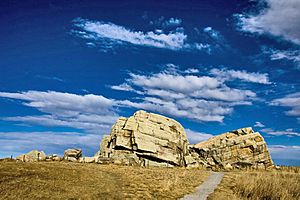Foothills Erratics Train facts for kids
The Foothills Erratics Train is a long, narrow line of thousands of large rocks found on the Canadian Prairies. These rocks are called glacial erratics, which means they were moved by glaciers. They are about 580 miles (933 km) long and between 0.62 miles (1 km) and 13.7 miles (22 km) wide. The rocks themselves can be anywhere from 1 foot (0.3 m) to 135 feet (41 m) long! The biggest rock in this train is called Big Rock.
This amazing line of rocks stretches along the eastern side of the Rocky Mountains in Alberta, Canada, and goes all the way south into northern Montana, USA. The rocks are mostly pink and purple quartzite, which is a very hard type of rock. These rocks are not naturally found in this area. They actually come from a place called the Tonquin Valley near Mount Edith Cavell in Jasper National Park, deep within the Rocky Mountains. Because they are so big and stand out on the flat prairie, these rocks were likely important landmarks for Indigenous people long ago.
How the Rocks Got Here
Around 12,000 to 17,000 years ago, near the end of the last Ice Age, something huge happened in the Tonquin Valley. A massive landslide occurred, sending millions of tons of quartzite rock onto a glacier in the valley.
This glacier then started to move, carrying the huge pile of rocks with it. As it left the mountains, this valley glacier joined up with other glaciers to become part of a giant ice sheet called the Cordilleran Ice Sheet.
Later, this Cordilleran Ice Sheet met another enormous ice sheet, the Laurentide Ice Sheet. When they met, the glaciers and the rocks they carried were pushed southward. They flowed side-by-side, parallel to the Rocky Mountains, all the way down to northern Montana.
Eventually, the ice sheets stopped moving and began to melt. As the ice melted away, the rocks were left behind in the long, narrow line we now call the Foothills Erratics Train.
Why the Rocks Look This Way
The rocks in the Foothills Erratics Train are often jagged and broken, but they didn't get smooth or show many scratch marks from the ice. This is because they rode on top or near the top of the glacier as it moved. If they had been carried at the bottom of the glacier, they would have been ground down and smoothed out.
The unusual straight line of these rocks was created because two very large ice sheets – the Cordilleran Ice Sheet from the west and the Laurentide Ice Sheet from the east – flowed smoothly alongside each other. The rocks were carried right along the boundary where these two massive ice sheets met.
If these rocks had been carried by water or by floating ice, they would have broken into tiny pieces, become very smooth, or spread out all over the place. But because they were carried on top of the glaciers, they kept their original shapes and stayed in this unique, long line.


